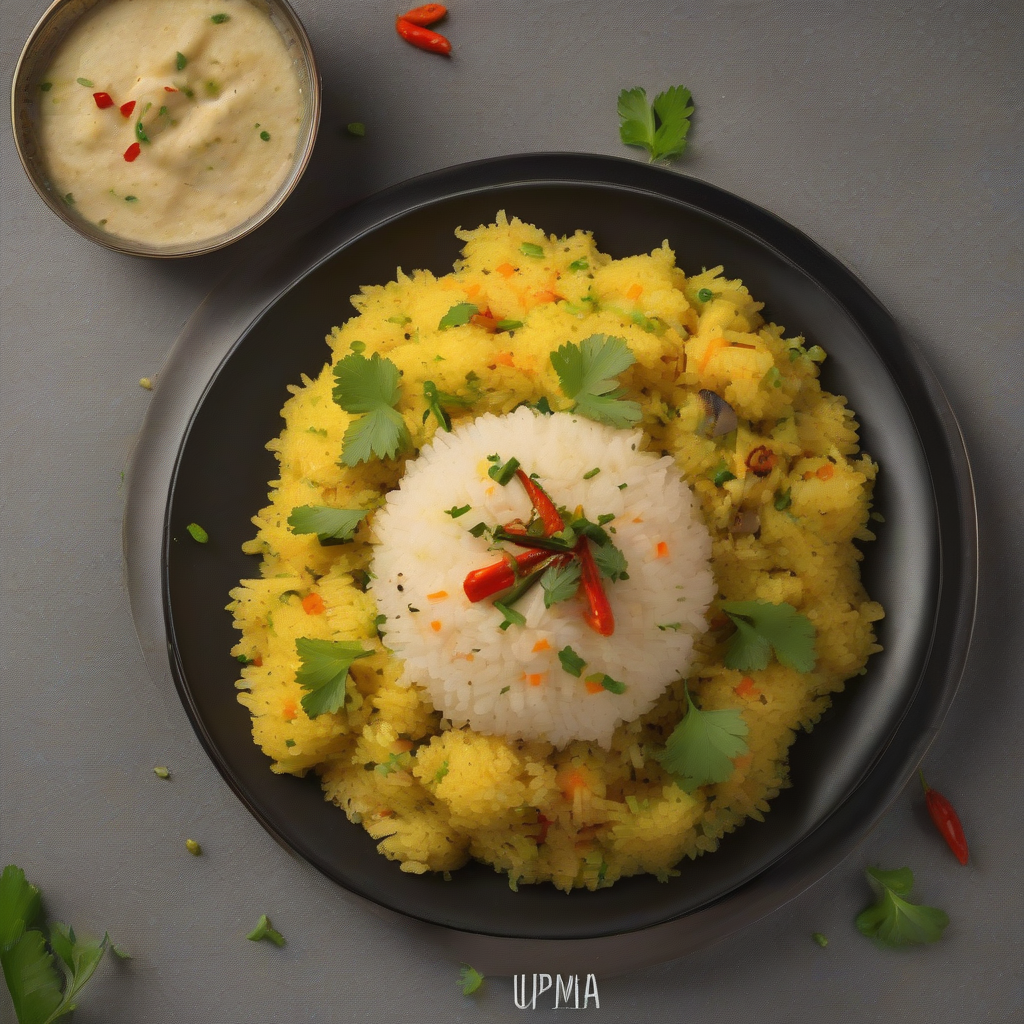Upma: A Humble Breakfast Fit for a Raja! (And You!)
Namaste, Salaam, and Sat Sri Akal, my dear foodie friends! Chef Curry Do’pyaza here, ready to share another gem from my kitchen straight to your hearts (and stomachs!). Today, we’re diving into the comforting world of Upma – a dish so versatile, so satisfying, and so deeply rooted in Indian culinary tradition that it deserves a standing ovation!
Upma is more than just a breakfast dish; it’s a warm hug on a chilly morning, a quick and easy meal when time is short, and a staple during festivals like Ugadi and Sankranti in South India. It’s the kind of dish that grandmothers lovingly prepare, and mothers pack in lunchboxes. It is a dish that brings people together.
A Whiff of History
The origins of Upma are a bit hazy, like the steam rising from a freshly made bowl. Some say it originated in South India, while others believe it evolved from similar dishes across the subcontinent. Regardless of its exact birthplace, Upma has been gracing Indian tables for centuries, evolving with regional variations and family secrets.
Let’s Get Cooking!
Preparation Time: 10 minutes
Cooking Time: 20 minutes
Ingredients:
- 1 cup Rava (Semolina)
- 2 tablespoons Tel (Cooking Oil – Vegetable, Sunflower, or Groundnut)
- 1 teaspoon Rai (Mustard Seeds)
- 1 teaspoon Urad Dal (Split Black Gram)
- 1 teaspoon Chana Dal (Split Chickpea Lentil)
- 1/2 inch Adrak (Ginger), finely chopped
- 1-2 Hari Mirch (Green Chillies), finely chopped (adjust to your spice level!)
- 8-10 Curry Patta (Curry Leaves)
- 1 medium Pyaaz (Onion), finely chopped
- 1/4 cup mixed Sabzi (Vegetables), chopped (Carrots, Peas, Beans – your choice!)
- 2 cups Pani (Water)
- Salt to taste
- 2 tablespoons Hara Dhaniya (Fresh Coriander Leaves), chopped for garnish
- 1 tablespoon Nimbu ka Ras (Lemon Juice)
Instructions:
- Roast the Rava: In a kadai or pan, dry roast the rava over medium heat until it turns slightly golden and fragrant. This usually takes about 5-7 minutes. Be careful not to burn it! Remove from the pan and set aside. This step is crucial for a fluffy, non-sticky upma.
- Tempering Time! Heat the oil in the same kadai. Add mustard seeds and let them splutter. Then, add urad dal and chana dal. Fry until they turn golden brown. This adds a lovely nutty flavor.
- Aromatic Infusion: Add chopped ginger, green chilies, and curry leaves. Sauté for a minute until the curry leaves release their fragrant aroma.
- Onion & Veggie Power: Add the chopped onions and sauté until they turn translucent and slightly pink. Then, add your choice of chopped vegetables and sauté for another 2-3 minutes.
- Water Works: Add 2 cups of water to the kadai and bring it to a rolling boil. Add salt to taste.
- Rava Revelation: Reduce the heat to low. Slowly add the roasted rava to the boiling water, stirring continuously to avoid lumps. Keep stirring until all the water is absorbed and the upma thickens.
- Steam & Serve: Cover the kadai and let the upma steam for 2-3 minutes. This ensures it’s cooked through and fluffy.
- Finishing Flourish: Remove from heat. Stir in the chopped coriander leaves and lemon juice. This adds a fresh, vibrant touch.
- Serve Hot: Serve your delicious, steaming upma hot!
Chef Curry’s Tips for Upma Perfection:
- Roast, Roast, Roast: Don’t skip the roasting step! It’s the secret to a light and fluffy upma.
- Water Ratio is Key: The 1:2 rava-to-water ratio is a good starting point, but you might need to adjust it slightly depending on the quality of your rava.
- Stirring is Essential: Continuous stirring while adding the rava prevents lumps from forming.
- Spice it Up: Feel free to adjust the amount of green chilies to your liking. You can also add a pinch of red chili powder for extra heat.
- Veggie Variety: Get creative with your vegetables! Bell peppers, tomatoes, and even spinach work beautifully in upma.
Upma Your Way: Cooking Methods for Every Kitchen
- Gas Stove: The traditional method, perfect for achieving a consistent texture.
- Induction Stove: Works just as well as a gas stove, offering precise temperature control.
- Pressure Cooker: For a quick and easy version, add all ingredients to the pressure cooker and cook for one whistle. Be careful not to overcook!
- Microwave: In a microwave-safe bowl, combine all ingredients and microwave on high for 3-4 minutes, stirring halfway through.
- Slow Cooker/Crockpot: Add all ingredients to the slow cooker and cook on low for 2-3 hours. This is a great option for a hands-off approach.
Nutritional Nuggets
Upma is a good source of carbohydrates, providing energy to kickstart your day. It also contains fiber from the vegetables and rava, promoting healthy digestion.
Serving Suggestions:
- Serve hot with a dollop of ghee (clarified butter) or a spoonful of coconut chutney.
- Pair it with a cup of hot chai or coffee for a complete breakfast.
- Add a side of yogurt or raita for a cooling contrast.
- Garnish with a sprinkle of sev (crispy chickpea noodles) for added crunch.
Your Upma Adventure Awaits!
So there you have it, my friends! A simple yet satisfying recipe for Upma that you can easily recreate in your own kitchen. I urge you to try this recipe at home and share the deliciousness with your loved ones. The aroma of Upma cooking in your kitchen is sure to bring smiles and create cherished memories. Happy cooking!
